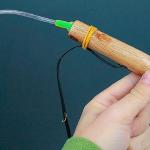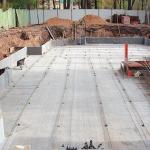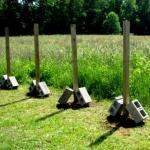Until the 19th century, most buildings in Russia were wooden. Considering the combustibility of this material, as well as the fact that open fire was constantly used in everyday life for cooking and lighting the house and streets, it is not surprising that fires occurred often. The fire took entire streets and even settlements: the methods of quickly extinguishing the fire had not yet been invented, and the flame, driven by the wind, quickly spread from house to house, and they flared up like matches. There are many documented cases when fires destroyed the most important city buildings and entire cities:
- in 1331, the wooden Moscow Kremlin burned to the ground;
- in 1337, all of Moscow perished from fire;
- in 1445 the Kremlin burned down again;
- in 1451 the Mongols attacked the city, and everything was on fire.
In most cases, the cause of the fire was some kind of accident: an overturned lamp, a carelessly placed candle in a church, a torch placed in close proximity to a dry tree. The only chance for salvation from the destructive flame was folk methods of wood processing and special techniques in the construction of houses. So, many preferred to divide the house into compartments in order to quickly separate the burning compartment from the rest of the building in the event of a fire. At the same time, a supply of food and candles was created in each compartment in case you had to stay locked up for a long time.
Processing wood with natural materials helped, but not much. Such buildings burned as before, but in order for the house to catch fire, an open flame was required, burning for an extended period of time. The following materials were used:
- Linseed and sunflower oil, which was oiled on wood. Despite the fact that the oil itself is a combustible material, in the composition of wood it stopped the further spread of fire well.
- Sealing the pores with resin also helped for a while. The main purpose of the resin was to slow down combustion, and not completely stop it.
- Wax coating. In case of small fires, the logs treated with wax slowly smoldered, allowing people to have time to call for help and put out the fire with joint efforts. By the way, the townspeople of that time quickly managed to eliminate small fires, but were powerless against a big fire.
In the 19th century, when the production of coal tar was established, the amazing properties of a by-product of this production, creosote, were discovered. They smeared the pillars that formed the basis of the foundation of the buildings of that time, and he did an excellent job of preventing fire. However, its use was limited due to the negative impact on the health of residents. Later, other materials were discovered that could replace creosote. Pentachlorophenol, which is an oily liquid, helped not only to resist fire, but also to resist wear. Ammonia copper arsenate, consisting of copper, arsenic and ammonia, was rubbed into the wood and temporarily protected from fire.
Today, the need to use these products has disappeared: various biopyrenes, which turn wood into a non-combustible material, do an excellent job with their task.
Currently, genuine leather products are considered symbols of prestige and quality. Mechanical processing, which they undergo during dressing, makes genuine leather really a very strong material, resistant to environmental influences. Have you ever wondered how the skin was processed before?
As it was
Pieces of animal skins have been the most popular material for making shoes and clothing since ancient times. Thousands of years ago, they were processed with stone scrapers, or even simply dried and put on without any dressing. But such skins quickly hardened and became oak, so people soon learned to soften them by beating them with stones or sticks, and then kneading them in their hands for a long time. This is how the first leather dressing specialists appeared.
A little later, people noticed that it was much easier to knead oily skins, and before dressing the skins began to be treated with oil or fat. In Japan, they used rapeseed oil for this, in the Caucasus - oil, in the regions of the North - the yolks of bird eggs, and in North America, the Indians rubbed their skins with a mixture of clay and buffalo urine.
According to historians, people learned to process leather even earlier than to make pottery. For example, a bag was made from skins to store water - a waterskin - which was convenient to carry with you. Leather, treated with tannins, completely changed its qualities, becoming pliable to dressing. Such substances were the juices of various plants and trees.
How did it become
At the moment, the most popular way of processing leather is chrome tanning - it is considered the fastest and most economical. However, the finest and most expensive leathers are still handcrafted using plant extracts.
The first metals that people learned to handle were copper and gold. The reason for this was the fact that both copper and gold are found in nature not only in ores, but also in pure form. People found whole nuggets of gold and pieces of copper and with the help of a hammer gave them the desired shape. Moreover, these metals did not even need to be melted. And although we still don't know exactly when people learned to use metals, scientists can vouch for the fact that man first used copper around the fifth millennium, and gold no later than the fourth millennium BC.
Around the third millennium BC, people discovered some of the most important properties of metals. By that time, man had already become acquainted with silver and lead, but copper was still used most often, mainly because of its strength, and, perhaps, also because copper was found in abundance.
Having started working with metals, people learned to give them the necessary forms and make dishes, tools, and weapons out of them. But as soon as a person got acquainted with metals, he could not help but pay attention to their useful properties. If the metal is heated, it becomes softer, and if it is cooled again, it hardens again. Man has learned to pour, boil and melt metals. In addition, people learned how to extract metals from ores, because they are much more common in nature than nuggets.
 Later, man discovered tin, and having learned to mix and melt copper and tin, he began to make bronze. In the period from 3500 to about 1200 BC, bronze became the main material from which weapons and tools were made. This period of human history is called the Bronze Age.
Later, man discovered tin, and having learned to mix and melt copper and tin, he began to make bronze. In the period from 3500 to about 1200 BC, bronze became the main material from which weapons and tools were made. This period of human history is called the Bronze Age.
Finding meteorites that fell on our Earth, people learned about iron - and long before they learned how to get it from terrestrial ores. Approximately in 1200 BC, man stepped over this barrier too - he learned to melt iron. This skill quickly spread throughout the world. Iron has replaced copper in almost all areas. This was the beginning of the next, Iron Age. By the way, during the time of the power of the Roman Empire, people knew gold, copper, silver, tin, iron, lead and mercury.
When was metal first used?
About 6,000 years ago, man lived in the Stone Age. It is named so because the main part of the tools of labor and hunting was made of stone. Man has not yet learned to make them out of metal.
Most likely, the first metals that man began to use were copper and gold. The reason is that these metals in nature existed both in pure form and as part of the ore. A man found nuggets of copper and gold and could give them various shapes without melting. We cannot say exactly when man discovered these metals, but it is known that copper began to be used at the turn of the fifth millennium BC. Shortly before the onset of the fourth millennium BC, gold was also used.
By the third millennium BC, man had already learned a lot in working with metal.
By this time, silver and lead had also been discovered, but nevertheless, in most cases, copper was the most commonly used metal due to its strength and prevalence.
At first, man learned to forge useful things from metal - dishes, tools and weapons. In the process of forging metal, he discovered the process of hardening, melting, casting and smelting. He also learned how to get copper from ore, which was more abundant than nuggets. Later, man discovered tin and learned to mix it with copper - a harder bronze was obtained. From about 3500 to 1200 BC, bronze was the most important material for making tools and weapons. This period is called the Bronze Age.
Man learned about the existence of iron by finding meteorites long before he discovered how to smelt it from ore. By 1200 BC, man had learned to work iron, and his skills were passed down from generation to generation. Iron has largely replaced bronze. This was the beginning of the Iron Age.
By the time of the rise of the Roman Empire, seven metals were known to man: gold, copper, silver, lead, tin, iron, and mercury.
When did the first saws appear?
Historians attribute the appearance of the saw to the Bronze Age, when people learned how to process metal. Perhaps this is so. The main issue was the construction of ships. All early ships were wooden. To build a ship, you need boards. And only boards. It is impossible to build a ship from round trunks. You can’t get a board out of the trunk with an ax, and if you do, it’s a very laborious process. But, as we know, ships were very common in ancient Greece. They, their fleet, became the basis of the ancient Greek colonization of the entire Mediterranean. The Greeks built a lot of ships, which means they needed a lot of boards. So, there were saws then. In ancient Greece, iron and steel tools were already quite used. Since there were swords and axes, there could have been saws as well.
Question - what? Most likely, these were hacksaw-type saws, that is, just long serrated knives. And as an option for their development - two-handed saws, for cutting bulky trunks. How old sawmills looked like can be seen in old drawings or in historical films. One man from above, one from below, there is a log in the middle, and they are sawing it. The process is laborious and monotonous. Naturally, any monotonous process is easier to automate, and this is how the first mechanical sawmills, driven by water power, appeared. Then, obviously, by the power of steam.
But the most interesting thing in this business is the appearance of a circular or circular saw. In sawing, the invention of the circular saw is as important as the invention of the wheel! There is no exact information about when and where the circular saw first appeared either. However, it can be assumed that these are the Middle Ages, the Middle Ages or the late Middle Ages, when there was a real explosion of all kinds of mechanical inventions. Until the advent of manual band saws.
The next step in the development of the "saw" business was the processing of metals with the help of saws. This was facilitated by the emergence of heavy-duty metals and alloys, as well as the technology of fixing diamond tools and abrasives on the cutting surfaces of saws. Such saws have long been sawing rails, cutting other massive metal volumes. There are also large machines that do these processes.
How did people process metals?

The first metals that people learned to mine and process were gold, copper and bronze. Metalworking was carried out with impact tools, the so-called cold bending method. Raw-blast furnaces were used to obtain many types of metals. In order to give the details the correct shape, the ancient masters polished the blank with a stone for a long time. After that, a new method was invented - casting. Detachable and non-detachable forms were cut out of wood or stone, then an alloy was poured into them, after which the metal cooled down, a finished product was obtained.
For the manufacture of figured products, a closed mold was used, for this a product model was molded from wax, then it was covered with clay and placed in an oven, where the wax was melted, and the clay repeated the exact model. Metal was poured into the void, after complete cooling, the form was broken and the craftsmen received a product of complex shape.
Over time, new ways of working with metal were comprehended, such as soldering and welding, forging and casting.
Today, there are new technologies that allow you to process metal much faster. Machining is carried out on lathes, which allows you to get the finished product with high accuracy.
Turning is the most popular way. It is produced on special metal-cutting machines, which are configured to perform work from a given type of metal. Lathes, in automatic and semi-automatic mode, are used for mass production of products with a rotating body shape.
Machine tools with numerical control are also used for metalworking. These machines are fully automated and the main purpose of the operator is to control the operation, set up the equipment, set the workpiece and remove the finished product.
Milling is a mechanical process for processing metals on universal milling machines, requiring an experienced specialist with deep knowledge in the field of metallurgy and metal processing methods.
To perform high quality milling work, it is important to use high-precision equipment. The degree of milling directly depends on the efficiency and productivity. Therefore, inaccuracies and errors in this matter are simply unacceptable.
Sources: otvet.mail.ru, potomy.ru, esperanto-plus.ru, operator-cnc.ru, www.protochka.su

Promising nanomotors
Living organisms can create nanoengines that are many times smaller than the smallest human-made engines. TO...

King Arthur Island
Avalon is a mythical island in the French and English adaptations of Celtic legends that have come down to us. The very word Avalon brought together ...
HISTORY OF THE DEVELOPMENT OF WOOD PROCESSING FROM ANCIENT TIMES TO THE PRESENT
, (UGLTU, Yekaterinburg, Russian Federation)
History of development of processing of a wood since ancient times till now
Wood is one of the oldest building materials known to mankind, which has always been and will remain popular in interior decoration. Nowadays, you can find fairly well-preserved windows, whose age has exceeded 100 years or more. The main advantages of wood are environmental friendliness, durability, wide processing and application possibilities. But these are its practical qualities, and for most people, the natural beauty of wood, the variety of its texture, tones and shades, excellent combinations with other interior elements are especially attractive. This allows us to call wood an elite material. However, the degree of eliteness of a tree and products from it largely depends on the type of wood and the method of its processing.
Features of woodworking are in its centuries-old traditions, constant focus on specific human needs, evolutionary development of labor methods, progressive renewal and expansion of the list of products, and a progressive increase in the marketability of production. The volumetric variety of mass types of woodworking products is increasing. By the endXIX century, it was already characterized by a 20-30-fold increase: industrial sawmilling appeared, machine (mechanical) wood processing and factory production of furniture were developed. IN XXcentury, marketability has increased more than 100 times. This happened on the basis of mechanization and automation of the production of traditional products (furniture, windows, doors, parquet, etc.), industrial production of wood-based panels. Such a rapid growth in marketability once again confirms the opinion of many experts: the "golden" age of wood is not so much in the past as in the future. After all, products made of wood and wood-based materials and semi-finished products (lumber, plywood, board materials) will be constantly needed by any society and person.
1. History of woodworking tools
Woodworking at the beginning of its development has long been an area of handicrafts with the use of almost exclusively manual labor.
The first type of mechanical wood processing was sawmilling, which appeared in Holland in the 11th century. The logs were sawn in so-called sawmills, which were a primitive sawmill frame driven by a windmill. Later, the drive of sawmill frames from water wheels (water saw mills) began to be introduced.
In Russia, the first saw water mill was built by Bazhenin in 1690 near Arkhangelsk, and in 1696 the first wind saw mill appeared there. Under Peter I, 30-40 such mills were built. Before the advent of saw mills in Russia, boards and beams were hewn out of logs with an ax.
Mechanical sawmilling has received significant development since the beginning of the 19th century as a result of the introduction of steam engines into the sawmill industry and the improvement of sawmills.
In the first half of the 19th century, peeling and horizontal planing machines were invented. This made it possible to obtain thin layers of wood by peeling and planing. The first plywood factory was built in Reval in 1887.
1.1. Woodworking tool in the III millennium BC. e.
When examining the burial inventory of the Royal Necropolis of Ur, a specific group of tools was found in the graves of persons of the highest social rank - kings and members of the royal family - among the mass of luxurious weapons, jewelry, precious vessels, etc. The burial inventory, which belonged to a child and is known in scientific literature as a “burial of a princess”, ceremonial weapons are included, among other things - a golden dagger and a spear made of electrum (an alloy of gold and silver), a copper-bronze socketed ax. But, in addition, there is a whole set of carpentry tools, also made of valuable materials. This is a golden socketed adze, two golden chisels and one bronze, as well as a bronze saw. The tomb of Queen Shubad/Pu-zbi also contains an extensive set of carpentry tools. These are several bronze saws and one gold one, five gold chisels belonging to two different types, a bronze drill and a socketed adze. In the burial of King Meskalamdug, along with weapons made of gold and electrum (dagger, socketed axes), a bronze saw was also found (Fig. 1).
|
|
1.2. Carpentry tool in ancient Rus'
The secrets of wood as a building material have long been unraveled. This is the most environmentally friendly and beautiful material that allows you to create an optimal microclimate in the room. Wood is alive, it "breathes", having a beneficial effect on the human body, moreover, it absorbs sound well, purifies and disinfects the air without causing allergic reactions. In log houses, a constant oxygen balance and optimal air humidity are maintained. The houses are warm in winter and cool in summer. Fatigue and irritation go somewhere in the wooden walls, and peace and tranquility are instilled in the soul.
Russia is a country of endless forests. A person living in the forest region could not but be a carpenter. Carpentry came along with agriculture from ancient times. Practically everything needed in household use, starting from the house and the "yard", was made of wood: spoons and tuesas, buckets, baskets and other utensils, furniture, spinning wheels and a weaving mill, a boat, a sleigh and a cart, hunting and fishing equipment, - even the chimney and chimney were wooden. A newborn man was placed in a wooden cradle, and an old man was seen off in a wooden domina on his last journey. And, of course, above all else, a man built a house for himself. "The wooden temples of the North breathed, shone and carried on a conversation with a person ... in conjunction with houses, threshing floors, baths. They ... crowned every, even a small village." And in the temple, a person worshiped a tree, prayed to a tree. Icons were painted on boards, iconostases, "royal gates", sculptures were carved from wood.
The construction of any building, even the smallest, was not complete without good tools. Not just good, but comfortable to hold in the hand, commensurate with the hand and body of a particular person (they say: "handy") and, of course, correctly and sharply sharpened. Each craft had its own tools, and each tool was used only to perform a specific operation. The carpenter did not work with a carpenter's ax, and the cooper's scraper was a little like a carpenter's.
1.2.1. Ax - the main tool in the past
The vast majority of all construction work was carried out with an ax. Trees in the forest were felled with a wood-cutting ax with a narrow blade, the cutting edge of which, compared to a carpenter's ax, was much farther from the ax handle.
This was necessary so that the ax, when struck, deeply obliquely entered the layers of the tree, but did not get stuck in the wood. Logs, chopping blocks, and boards were hewn with a protes with a wide, rounded blade (Fig. 2).
The word "ax" is of Turkic origin, it came to Rus' along with the Tatar-Mongol invasion and replaced the Russian word "axe". In the village of Ratonbvolok (Kholmogorsky district of the Arkhangelsk region), a real ax has survived to this day! A slightly curved handle, polished by many hands, is fitted with a long sickle-shaped blade with an elongated toe and a straight heel. The length of the blade was 35 cm, and the total length with the handle was almost a meter. The ax has been preserved in perfect working order: tightly wedged and sharply sharpened. With such an ax you can not only cut a log or block, but you can safely go to battle with the Horde.
They used a carpenter's ax to hew logs, cut out bowls in them, made knots for connecting elements, decorative details, and much more. Carpenter's ax XVII-XVIII centuries. significantly different from today. The ax itself (the metal part) was short, tear-shaped in cross section, the blade was not wide (9-15 cm), semicircular, thickened, with a large wedge-shaped shape (resembling the shape of a cleaver for splitting firewood, logs) (Fig. 2b), and the ax itself is heavier . Axes were forged from especially resistant, high-strength steel. The ax (handle) is long and straight (and not curved, as modern), thickened at the end so that it does not jump out of the hands. For the ax handle, a straight birch chopping block without knots was chosen. The length of the ax handle was different, because it depended on the height of the carpenter: the carpenter, placing the ax on the ground vertically near his foot, with his freely lowered hand, could take the thickened end of the ax handle into his fist (Fig. 2c). A long ax, being, in fact, a lever, allowed the carpenter to spend less effort.
 |
Carpenter's ax XVII-XVIII centuries. when hewing, it cleaves wood without sinking deep into it and leaving no traces in the form of scratches, scratches and notches, and with its concave side and its mass, upon impact, it simultaneously compacts the wood on the surface to be treated. When working, the ax was held in hands so that its blade was not directed parallel to the log, but moved in an arc towards it - then at the end of the blow the ax itself came out of the tree. If the ax nevertheless stopped in the wood and thereby left a scuff, the latter was removed by the next blow, applied before the end point in the log of the previous blow. By these means, the cut wood fibers were tightly adjoined to each other without scuffing. A thin ax goes deep into the wood and gets stuck there, which makes it very difficult to cut.
Blocks and roofing boards were hewn in two directions - back and forth - alternately, in stripes, along the log. The width of one strip was equal to the width of the ax blade. Ax XVII-XVIII centuries. left characteristic traces on the hewn planes. On the board, a pattern was obtained that looked like a herringbone or the ribs of a fish skeleton, and in the longitudinal section of the board these traces were wavy, reminiscent of a washboard. The surface of the hewn boards turned out to be so smooth that one could not even put a hand on it, and at the same time not flat and even, but embossed, wavy. From the surface treated in this way, rainwater was removed more easily, so hewn boards were less exposed to moisture and biodamage (rotting).
The work of a carpenter is physically very difficult, requiring a lot of energy, so the carpenters were fed with meat cabbage soup even in the midst of haymaking and in Lent. “A good carpenter, of course, never interfered with heroic strength. But even without it, he was still a good carpenter. on a par with talent and skill, but on its own. Real carpenters saved strength. They were unhurried. They didn’t work without one-row mittens."
A young worker, usually a teenager, began to comprehend the art of carpentry with an ordinary ax handle. To make an ax means to pass the first exam. The hatchet was made from dry birch blanks. "The ax must also be planted, and wedged correctly so that the ax does not fall off, and cleaned with a glass shard. After all this, the ax was sharpened on a wet grindstone. Each operation in itself required ingenuity, skills and patience. This is how life taught in childhood and adolescence future carpenter to patience and consistency.
In most carpentry work, the ax was held with two hands; the bowl was chopped from two sides, striking alternately, now on the right, then on the left. Which side to hit, right or left, was determined by the location of the wood fibers in order to press the cut fibers upon impact. Therefore, the ax blade was sharpened symmetrically, on the same chamfers, at the same angle. However, sometimes, due to the specifics of the processing of the element, the sharpening of the blade was made asymmetrical.
The ax was never stuck into a log intended for construction, because then the meaning of densely hemming its surface disappeared. In general, logs prepared for laying in a building, i.e., debarked (sanded), hewn and scraped, as well as finished parts, were handled very carefully, protecting them from mechanical damage, dirt, etc. a scratch is a "gate for infection". This increased the likelihood of biodamaging the wood of the building element and, in the end, could shorten the life of the entire structure.
The ax was never left stuck in a log or block of wood and was not placed against the wall, but only placed under the bench. Moreover, the ax was turned with a blade to the wall, so that no one would accidentally get hurt, lifting something rolled under the bench. In general, any actions associated with a threat to health when working with an ax and other tools were specially warned.
To trim the log walls from the inside of the room, a special ax was used, the blade of which was straight and somewhat elongated compared to a conventional carpenter's ax, and the blade itself was turned at an acute angle so that the axis of the ax head was parallel to one edge of the blade. (Fig. 3a). The ax handle for such an ax was specially selected from a thin twisted tree trunk so as not to upholster the hands during work. In this case, the carpenter needed two mirror-forged axes, i.e. one with the blade offset to the right of the carpenter, for cutting from right to left, the other with an offset to the left, for trimming from left to right. In the corners, the surface of the logs was hewn in an arc. It turned out a "round" corner. The trimming was carried out from the corner to the middle of the wall. Do not trim the left side of the corner, rounded in an arc, with the "right" ax. Instead of two axes, one was sometimes used, but double-edged, double-sided, which had one eye and two mirror-forged blades (Fig. 3b). It was with such axes that the Arkhangelsk masters hewed the walls.

In this case, the angle of sharpening the ax also mattered. The ax blade was sharpened asymmetrically, at different sharpening angles, depending on which side the wall was hewn from - on the right or left (Fig. 3c). The chamfer of the ax blade, facing the wall during trimming and intended for cutting wood (i.e., the external chamfer in relation to the carpenter, parallel to the axis of the ax handle), was sharpened at a sharper angle relative to the axis of the blade than the other. The inner chamfer, intended for chipping chips, was sharpened at a less acute angle. Such an asymmetry of the sharpening angles allows the blade to be in reliable contact with the surface to be treated, the ax does not slide on it and does not bounce, it is, as it were, "pulled" into the wood.
In the "Course of carpentry work ...", released in 1906, a "transverse" ax is presented, also intended for "cutting log walls", the straight blade of which was turned perpendicular to the ax handle, in fact it turned out to be a broadened adze with a flat blade. Modern practicing carpenters-restorers suggest that only "round" corners in the interior were hewn with such an ax, because it is inconvenient for them to hew the vertical surfaces of the walls. In addition, after processing with such an ax, the vertical surface of the walls remains uneven, with large waves that would have to be removed with a scraper and planer in several passes.
1.2.2. Adze, devil, drag and other tools
An adze is, in fact, also an ax, the ax handle of which is long and straight, and the blade is not only turned perpendicular to the ax handle, but also has a semicircular section, in the form of a scoop (Fig. 3a). With an adze, gutters of various sizes were hewn on a log along its fibers (for example, a shallow groove in a log intended for laying in a wall, or a deep gutter), sections of a smooth transition from a round log to a beam at window and door openings were made, after the ax hewed "round corners" in the interior and other curved surfaces. Paznik - an adze with a narrow flat blade - served for the final, finishing excavation of manholes after cutting the groove rough with an ax (Fig. 36). As a rule, the groove was first cut down rough with an ax until a U-shaped profile was obtained, and then, in the depths of the manhole, the wood was selected with a groove.
A carpenter's ax differs from a carpenter's ax in smaller sizes and less weight - after all, the carpenter does not process logs, but smaller structural parts. The toe of the carpenter's ax is sharp, and the blade is straight. But there were also cleavers, cooper and wheel axes, and even the "American" one, the butt of which was replaced by an ordinary four-sided hammer. But these are tools of other crafts.
A line is the most common tool for drawing parallel straight or curved lines on the surface of wood for the purpose of subsequent trimming or sawing logs and building details. To do this, carefully, "by a thread" hewed the edge of one board. The next board was applied to this edge and, firmly pressing the line to the straightened edge, they scratched, drew a deep parallel scratch with a metal point on the adjacent board or adjacent structure. According to this scratch-line, the adjoining edge was hewn. Marking with a line requires accuracy, since the mark left is a deep scratch: this is not a pencil mark - you cannot erase it. By loosening or tightening the winding of the line or by fixing the distance with a wedge and a ring, the distance between the sharp ends of the line was changed. The logs were drawn with a line to select a longitudinal groove in order to achieve a tight fit of the logs in the walls, a bowl in the logs before its finishing. With the help of the line, they drew (beat off) and then cut out a smooth edge of the blocks and boards for their tight fit (they laid them in the line or in the line), The line marked the junctions of the elements and made other marks, which now the carpenters mark with a pencil. Subsequently, along with the line, a carpenter's compass was used.
With a large number of boards, it is more convenient to draw them with the help of a drag, taking the boards into a kind of machine. In the Arkhangelsk Territory, this tool is called a "finch", they say: "draw under the finch", "gain the floor under the finch", that is, especially tightly, without the slightest cracks.
Subsequently, in many technological operations, the line and the drag were replaced by a thickness gauge. "Thickness gauge" - a German word, literally means "a tool for drawing parallel lines" (thickness machine, T-square gauge). The thickness gauge was also used to transfer dimensions from one part to another. The principle of its operation is similar: drawing a scratch on the wood with a sharp hairpin, only instead of a ring and a wedge, like a dash, the thickness gauge has a movable block, which is fixed with a screw.
For finishing, after an ax, debarking logs and removing sapwood, a plow, or a scraper (from "scrape") was used. This tool was a scraper, a sickle-shaped metal plate with a cutting edge and two handles. In some areas of central Russia, this scraper was called a hak (from the strained sound "ha" made by a carpenter when working with this tool). There were two types of it: straight and rounded (curve). With a scraper, the bark was removed from the logs at the border of the bast, without damaging the wood, and at the same time the surface of the log was leveled, cutting off irregularities and small knots. The logs were barked in the direction from the butt to the top, so as not to leave scratches. When debarking a log with an ax, chips and serifs would inevitably appear, which increased the likelihood of biodamages; when processing with a scraper, the surface of the log turned out to be smooth and without burrs. Logs with an intact, dense and smooth surface remain in the building for an unusually long time.
The “waves” remaining after processing with an ax and adzes were also removed from the hewn surface with a scraper and the surface was brought to a perfectly smooth surface. Walls, roofing boards, door and window jambs, door and shutter panels were scraped. It should be noted that structural elements were scraped only in small volumes or in the interior of churches and living quarters of the house, since it is very difficult to work with a scraper, more difficult than with a planer. Straight surfaces were scraped with a straight scraper, "round" corners in the interior - round. Jambs of door and window openings, door leafs, boards, etc. were scraped along the fibers of the wood, while the walls were scraped at an angle of about 60 ° to the axis of the log. Due to the fact that the logs of the walls had to some extent the slope of the fibers, they were scraped in two directions: half a log - in one direction, half a log - in the other. After the scraper, the surface treatment was completed.
Along with the groove, the grooves in the window and door jambs were cleaned with a spiked chisel. A flat chisel and a clearing were wider and thinner than a tenon chisel, they cleaned grooves and nests from the sides and punched holes in building elements. For the most delicate, delicate work, a chisel was used. A chisel, a clearing and a chisel were sharpened only on one side.
To drill holes, various drills were needed: spoon, screw, feather ("pepper", "perk"). They drilled nests for dowels ("kuksy") in the logs of the log house.
The saw appeared in Russia under Peter I, and entered into everyday carpentry use only in the 19th century. A two-handed cross saw is needed for sawing logs across the fibers. A bow saw, also a transverse one, used to cut down trees in the forest. The bow saw looks like an X-shaped frame, on one side of which the saw blade was fixed, and on the other side the blade was stretched with a twist - a bowstring. Its cutting blade is flexible, the steel is hard. A narrow blade, no more than 5 cm wide, was inserted into the bow saw in order to protect the blade from pinching when cutting trees of large diameter. For cutting logs along the fibers, a special two-handed fly saw (longitudinal) with long oblique teeth and a small divorce was used. A hacksaw is used to make longitudinal and transverse cuts and slots in thin elements and boards.
A regular planer for a carpenter was also optional. This is a carpentry tool. A preliminary, rough cut of the material (roofing board, building elements) was performed with a medvedon (medvedka) planer, they worked together, a planer with a semicircular blade (sherhebel) also performed a rough cut, but with one pair of hands, and then the board was planed with a planer with one or two blades (one knife-blade was called a piece of iron, the other, breaking chips, was called a slab). An ordinary planer has one blade (piece of iron) with a straight lower end. Planing is easier if the planer is not driven strictly along the wood fibers, but at a slight angle to them - this is how the pickup blade removes chips. The thinner and longer it is, the more noble the surface is. Finally, the surface of the board or part can be passed with a jointer. For planing a quarter and a tongue, a zentoubel was used, for profile processing of edges - a selector, and to create a relief surface of the board - calevka.
The square was used to beat only the right angle of the bevel - the same square, but with one movable edge - was used to remove and mark various angles. A folding arshin (later a meter) is also necessary for a carpenter. All other auxiliary devices were made by the carpenters themselves in the course of work (plumb lines, string, wedges, etc.).
Wedges were needed for many works: they were inserted into cuts, splits and splits to prevent clamping of tools, building elements were clamped with wedges for their tight joining (for example, floor blocks), gaps in the nodes and joints of elements were straightened by wedging, tool handles were wedged, wedges were placed to correct small carpentry flaws. It is not in vain that they say: "The wedge is the first assistant to the carpenter", "Not a wedge and not moss - and the carpenter would have died."
The tool and the historical technology of wood processing are of cultural and historical value.
2. Development of woodworking in the XXI century
The efficient use of wood in combination with new materials has improved its properties. Currently, up to a thousand items of products are made from wood. Resources of wood as a natural material are constantly being restored.
The woodworking industry, which is part of the timber industry complex (LPK), includes various industries that can be divided into two groups: primary and secondary wood processing.
The primary processing group includes industries that are characterized by the consumption of timber (production of lumber, production of veneer, plywood, wood-based panels, plastics and other wood-based materials) and their manufacture of semi-finished products from them by mechanical, hydrothermal processing and gluing.
Secondary processing group - mechanical processing of wood and gluing semi-finished products from it in order to obtain parts that later undergo a protective and decorative finish, are assembled into knots, and then into a specific product.
The demand for woodworking products is determined by the usefulness of the product and the level of effective demand for it and has a decisive influence on the marketability, if its scale ensures mass production. Mass production is unthinkable without new methods of labor, i.e. technology, and new technological equipment.
The usefulness of products is determined by a complex of factors: technical, ergonomic, environmental, social, etc. Ignoring these facts when creating new products inevitably affects demand and marketability. More than 30 years ago, industrial production of wooden windows without vents was organized in the USSR. More productive technology and lower costs clashed with utility, and the new product was not widely used. Many woodworking enterprises produced what they could, and not what the consumer needed. To produce the required (ordered, even paid) products, and not to create difficulties for oneself with the sale (sale, exchange) of already produced products - this principle of responding to demand was the first to be implemented by furniture makers, introducing trade in samples of products or their sets. Therefore, it seems obvious that the demand criterion will become a priority and will become decisive for the development of woodworking.
2.1. The latest developments in the woodworking industry
Everyone knows the term "eurowindow". Currently, wooden, wood-aluminum and plastic (PVC) windows are produced. Plastic windows have practically replaced other materials for windows from the field of civil engineering and have been actively introduced into housing construction. They are opposed by windows made of massive glued timber. Similar processes are developing in the furniture industry: the front parts of cabinet furniture made of solid wood, MDF, lined with chipboard compete. The development of new and improvement of manufactured types of composite (plate-sheet) materials will initiate an in-depth study of the processes of molding and pressing materials in order to give them the required properties and operational control of these properties during the entire production cycle. The builders' need for new products and structures made of wood will determine the increased interest in researching the properties of wood and operational methods of product quality control.
Marketability of woodworking products in the first thirdXXI century will increase by at least 2 times, because the range of composite materials based on wood is constantly expanding, the demand for solid wood products is increasing, and the volume of wood use in construction is growing. The requirements for the completeness of the development and the timing of its implementation will increase. Increasing competition between old and new types of products, between wood and alternative materials, against the backdrop of growing demand for solid wood products, will become an effective factor in ensuring product quality. The demand for new products and structures made of wood for construction determines the increased interest in researching the properties of wood and developing methods for the operational quality control of products.
2.1.1. Wood seal
For many years, one of the disadvantages of wood was considered to be the limited possibility of its molding. At the Dresden University of Technology, specialists have developed and patented a new technology for processing wooden structures, which significantly expanded the scope of their application. On the end of the beam, processed by the Dresden method, it is clear that the annual rings are oval, as if flattened. Peer Haller, Professor at the Institute for Building Structures and Timber Structures at the University of Dresden (peer haller) explains that the wood has been compacted. The compaction process is carried out at a temperature of 150º C with a hot press. In this case, the wood microstructure is compressed, and as a result, wood of very high density is obtained - approximately 1 kg / dm3. Dry spruce wood in its normal state has half the density, since it is a kind of sponge. It is the high porosity of wood that makes it possible to obtain beams of rectangular cross section from round trunks by hot pressing without any loss.
During the construction of large engineering connections, for example, bridges, loads are distributed extremely unevenly. As a result, individual beams are subject to increased wear. If these beams are made from compacted wood and the rest from regular wood, this will preserve the architectural harmony of the bridge and at the same time provide optimal performance.
Where the expected loads are especially high, engineers use steel beams of various profiles (T-section or I-section). But also hollow beams of box-shaped or round section are capable of carrying a greater load than solid massive beams. The technology developed by Professor Haller makes it possible to obtain hollow beams from wood. To do this, first the round barrel is pressed into a square bar, and then the deformation is removed from one side. As a result, the square section turns into a trapezoidal one, and this makes it possible to fold a hollow pipe from several such beams.
2.1.2. Combination of wood with polymer
Currently, technologists are trying to combine a wooden base with a polymer coating. For these purposes, glue is used, but the desired result is not always obtained. The specialists of the Laser Center in Hannover proposed another method - the use of a laser. One of the developers Stefan Barczykowski (Stefan Bartcikowsky) says: - It is necessary to imagine the matter in such a way that the plastic for the laser beam is transparent. The laser beam, as it were, looks through the plastic, not noticing it, but sees the wood behind it. And it is there, on this border, that the laser energy is concentrated. The wood heats up and melts the plastic, so that a strong welded joint is formed, which has significant advantages over glued ones. The energy of the laser beam must be chosen so that the temperature in the boundary layer does not exceed 400º, otherwise the wood begins to char. Most polymers begin to melt at 90 degrees. The melt flows into the pores of the wood and a strong bond is formed. When testing samples, the break does not occur in the joint zone, but in the thickness of the material, which is a good sign. This means that the resulting welded joint is stronger than the materials being joined. Pilot plant of Hannover engineers ensures welding speed - 1m/min. The authors of the development intend to increase the laser power (currently, the laser power is 100 W) and increase the welding speed to 80 m/min.
2.1.3. Wood in the production of ceramics
Wood is beginning to be used in the manufacture of ceramics. Until now, mineral powders served as the starting material for it - for example, finely ground silicon carbide was placed in a mold and sintered. But grinding and sintering are very energy-intensive processes. Therefore, American engineers have developed a more environmentally friendly technology for the production of ceramics: it not only requires less energy, but also uses a renewable raw material - wood - as a starting material. Mrityanjay Singh, NASA Ceramic New Materials Research Scientist in Cleveland, Ohio, says: “We can even use sawdust, which is a big problem for sawmills to dispose of. Astringents are added to the sawdust, then the resulting mass is shaped into a future part, after which this workpiece is subjected to pyrolysis (decomposition under high temperatures in an oxygen-free environment). It is this process that turns wood into charcoal, which is chemically pure carbon. And then silicon is added to the furnace - the second component of the future carborundum ceramics. In addition to silicon compounds, melts of some salts can also be used, which makes it possible to produce a wide range of modern ceramics. The peculiarity of the proposed technology is that the microstructure of wood is preserved throughout the entire process, and the ceramics, as it were, takes over some properties of the original material.
CONCLUSION
New technologies may appear both as a result of the creation of fundamentally different types of composite materials, and as a result of the use of new operations for woodworking - for example, stamping in the manufacture of products from dense materials - in the mass production of socially accessible products.
Two factors will be decisive for the development of new methods of work, even in the manufacture of traditional products: the tightening of requirements for the quality of products and the desire for the rational use of wood. In particular, sawless cutting of wood will eliminate the formation of soft wood waste (sawdust, dust, etc.), will allow to obtain high quality surfaces and, possibly, abandon a number of currently used grinding techniques. The physical and technical methods of such wood processing can be of a different nature (vibration, radiation, water hammer, etc.).
Increasing requirements for product quality will lead to fundamental changes in the processes of its protection (impregnation, finishing). Such changes will most likely lead to an increase in the use of protective and finishing materials (such as Pinotex, Lazurol), exacerbate the problem of inexpensive weather-resistant varnishes, protective films, etc.
Also, the problem will be to ensure a high (up to 80-90%) level of automation of all technological operations (from the preparation and supply of raw materials to packaging and storage of products). The solution to the problem lies in the creation of automatic control and regulation systems, since they make it possible to practically eliminate manual labor in mass production.
The problem of wood-cutting tools, regardless of new ways of cutting wood, will obviously be resolved in two interrelated directions: the creation of new types of tools based on a deeper knowledge of the properties of wood and new structural materials (steels, alloys, etc.).
Bibliographic list
1. To the question of the origins of the ancient culture of the Near East (Excavations of Nevali-Chori) /,. // Bulletin of ancient historyN 1. - c. 36-47.
2. Deacons of the ancient East. The origin of the oldest class societies and the first centers of slave-owning civilization. Part I. Mesopotamia. Ed .. M. 1983. - p. 24-69.
3. Kramer begins in Sumer. M. 1965. - p. 58-91.
4. Belov life of the Russian North. M. 2000. - p. 36-47
5. Cheap wood technology. - L .: Gostekhizdat, 1936. - T.1. With. 98-106.
6. http://***** [Electronic resource]


















